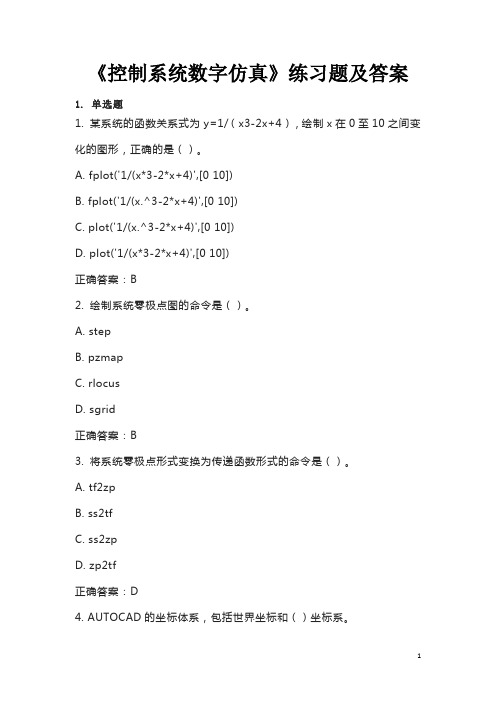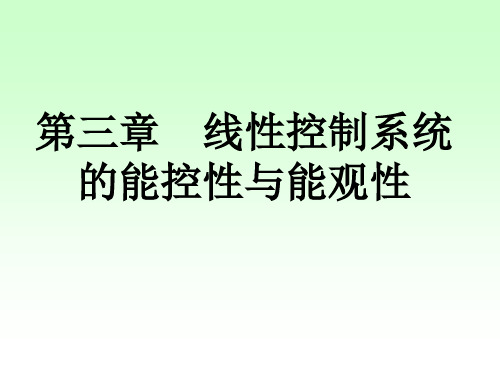山东大学线性控制系统2012年考试题目(参考)
- 格式:doc
- 大小:1.60 MB
- 文档页数:2


《控制系统数字仿真》练习题及答案1. 单选题1. 某系统的函数关系式为y=1/(x3-2x+4),绘制x在0至10之间变化的图形,正确的是()。
A. fplot('1/(x*3-2*x+4)',[0 10])B. fplot('1/(x.^3-2*x+4)',[0 10])C. plot('1/(x.^3-2*x+4)',[0 10])D. plot('1/(x*3-2*x+4)',[0 10])正确答案:B2. 绘制系统零极点图的命令是()。
A. stepB. pzmapC. rlocusD. sgrid正确答案:B3. 将系统零极点形式变换为传递函数形式的命令是()。
A. tf2zpB. ss2tfC. ss2zpD. zp2tf正确答案:D4. AUTOCAD的坐标体系,包括世界坐标和()坐标系。
A. 绝对坐标B. 平面坐标C. 相对坐标D. 用户坐标正确答案:D5. 在MATLAB工作空间中,表示圆周率的特殊变量是()。
A. piB. ansC. iD. eps正确答案:A6. 下列哪条指令是求矩阵的行列式的值()。
A. invB. diagC. detD. eig正确答案:C7. 在CAD网络系统中,以下说法不正确的是()。
A. 设计资料可以共享B. 硬件可以共享C. 电脑文件可以共享D. 可以方便管理设计进度正确答案:C8. i=2; a=2i;b=2*i;c=2*sqrt(-1);程序执行后;a, b, c的值分别是()。
A. a=4,b=4,c=2.0000iB. a=4,b=2.0000i, c=2.0000iC. a=2.0000i, b=4,c=2.0000iD. a=2.0000i,b=2.0000i,c=2.0000i正确答案:C9. 在循环结构中跳出循环,执行循环后面代码的命令为()。
A. returnB. breakC. continueD. keyboard正确答案:B10. figure命令的作用是()。

现代控制理论-3
一、回答下列问题
1.连续系统离散化的主要原则是什么?
2.线性变换有哪几条基本性质,这些性质的内容是什么?
3.状态反馈是否改变原系统的能控性、能观测性。
二、问答
1.已知离散系统的状态空间表达式为:
(2)求系统的脉冲传递函数G (z)。
2.已知系统的状态空间表达式为
[]x
y u x b a x 111101-=⎥⎦⎤⎢⎣⎡+⎥⎦⎤⎢⎣⎡=&
(1)确定使系统状态完全能控的a 和b 应满足的条件;
(2)确定使系统状态完全能观的a 和b 应满足的条件。
3.已知系统的状态空间表达式为
[]03001210x x u y x
⎡⎤⎡⎤=+⎢⎥⎢⎥-⎣⎦⎣⎦=&
试利用状态反馈设计一个闭环系统,使希望的闭环极点为-2,-3。



现代控制理论试题B 卷及答案一、1 系统[]210,01021x x u y x ⎡⎤⎡⎤=+=⎢⎥⎢⎥-⎣⎦⎣⎦能控的状态变量个数是,能观测的状态变量个数是cvcvx 。
2试从高阶微分方程385y y y u ++=求得系统的状态方程和输出方程(4分/个)解 1. 能控的状态变量个数是2,能观测的状态变量个数是1。
状态变量个数是2。
…..(4分)2.选取状态变量1x y =,2x y =,3x y =,可得 …..….…….(1分)12233131835x x x x x x x u y x ===--+= …..….…….(1分)写成010*********x x u ⎡⎤⎡⎤⎢⎥⎢⎥=+⎢⎥⎢⎥⎢⎥⎢⎥--⎣⎦⎣⎦…..….…….(1分)[]100y x = …..….…….(1分)二、1给出线性定常系统(1)()(),()()x k Ax k Bu k y k Cx k +=+=能控的定义。
(3分)2已知系统[]210 020,011003x x y x ⎡⎤⎢⎥==⎢⎥⎢⎥-⎣⎦,判定该系统是否完全能观?(5分)解 1.答:若存在控制向量序列(),(1),,(1)u k u k u k N ++-,时系统从第k 步的状态()x k 开始,在第N 步达到零状态,即()0x N =,其中N 是大于0的有限数,那么就称此系统在第k 步上是能控的。
若对每一个k ,系统的所有状态都是能控的,就称系统是状态完全能控的,简称能控。
…..….…….(3分) 2.[][]320300020012 110-=⎥⎥⎥⎦⎤⎢⎢⎢⎣⎡-=CA ………..……….(1分) [][]940300020012 3202=⎥⎥⎥⎦⎤⎢⎢⎢⎣⎡--=CA ……..……….(1分) ⎥⎥⎥⎦⎤⎢⎢⎢⎣⎡-=⎥⎥⎥⎦⎤⎢⎢⎢⎣⎡=940320110 2CA CA C U O ………………..……….(1分) rank 2O U n =<,所以该系统不完全能观……..….…….(2分)三、已知系统1、2的传递函数分别为2122211(),()3232s s g s g s s s s s -+==++-+求两系统串联后系统的最小实现。
现代控制理论试卷一、简答题(对或错,10分)(1)描述系统的状态方程不是唯一的。
(2)用独立变量描述的系统状态向量的维数不是唯一的。
(3)对单输入单输出系统,如果1()C sI A B --存在零极点对消,则系统一定不可控或者不可观测。
(4)对多输入多数出系统,如果1()sI A B --存在零极点对消,则系统一定不可控。
(5)李雅普诺夫直接法的四个判定定理中所述的条件都是充分条件。
(6)李雅普诺夫函数是正定函数,李雅普诺夫稳定性是关于系统平衡状态的稳定性。
(8)线性定常系统经过非奇异线性变换后,系统的可控性不变。
(9)用状态反馈进行系统极点配置可能会改变系统的可观测性。
(10)通过全维状态观测器引入状态反馈来任意配置系统的闭环极点时,要求系统必须同时可控和可观测。
对一个线性定常的单输入单输出5阶系统,假定系统可控可观测,通过设计输出至输入的反馈矩阵H 的参数能任意配置系统的闭环极点。
二、试求下述系统的状态转移矩阵()t Φ和系统状态方程的解x 1(t)和x 2(t)。
(15分)1122()()012()()()230x t x t u t x t x t ⎡⎤⎡⎤⎡⎤⎡⎤=+⎢⎥⎢⎥⎢⎥⎢⎥--⎣⎦⎣⎦⎣⎦⎣⎦12(0)0,(),0(0)1tx u t e t x -⎡⎤⎡⎤==≥⎢⎥⎢⎥⎣⎦⎣⎦ 三、设系统的传递函数为()10()(1)(2)y s u s s s s =++。
试用状态反馈方法,将闭环极点配置在-2,-1+j ,-1-j 处,并写出闭环系统的动态方程和传递函数。
(15分) 四、已知系统传递函数2()2()43Y s s U s s s +=++,试求系统可观标准型和对角标准型,并画出系统可观标准型的状态变量图。
(15分)五、已知系统的动态方程为[]211010a x x uy b x ⎧⎡⎤⎡⎤=+⎪⎢⎥⎢⎥⎨⎣⎦⎣⎦⎪=⎩,试确定a ,b 值,使系统完全可控、完全可观。
线性控制系统工程课后习题答案Module 1: Introduction to Linear Control SystemsExercise 1QuestionConsider a control system with transfer function:$$ G(s) = \\frac{10}{s+2} $$Find the steady-state value of the output when the input is a unit step function.SolutionThe Laplace transform of a unit step function is given by:$$ U(s) = \\frac{1}{s} $$The steady-state value of the output can be obtained by evaluating the transfer function at s=0:$$ G(s=0) = \\frac{10}{s+2} = \\frac{10}{2} = 5 $$Therefore, the steady-state value of the output is 5 when the input is a unit step function.Exercise 2QuestionConsider a control system with transfer function:$$ G(s) = \\frac{4}{s^2 + 4s + 3} $$Find the poles and zeros of the transfer function.SolutionThe poles are the roots of the denominator polynomial. Therefore, we need to find the roots of the equation:s2+4s+3=0Using the quadratic formula, we can find the roots:$$ s = \\frac{-b \\pm \\sqrt{b^2-4ac}}{2a} $$In this case, a=1, b=4, and c=3. Substituting these values into the formula, we get:$$ s_{1,2} = \\frac{-4 \\pm \\sqrt{4^2-4(1)(3)}}{2(1)} $$ Simplifying this expression, we get:s1=−1s2=−3Therefore, the poles of the transfer function are -1 and -3.To find the zeros, we need to find the roots of the numerator polynomial, which in this case is a constant. Since there are no variables in the numerator, there are no zeros. Therefore, the transfer function has no zeros.Module 2: System ModelingExercise 1QuestionConsider a control system described by the following differential equation:$$ 4\\frac{d^2y(t)}{dt^2} + 8\\frac{dy(t)}{dt} + 6y(t) =2u(t) $$Determine the transfer function of the system.SolutionTo find the transfer function, we need to take the Laplace transform of both sides of the differential equation. The Laplace transform of the left side can be written as: $$ \\mathcal{L}\\left(4\\frac{d^2y(t)}{dt^2} +8\\frac{dy(t)}{dt} + 6y(t)\\right) $$Using the linearity property of the Laplace transform, we can split this expression as:$$ 4\\mathcal{L}\\left(\\frac{d^2y(t)}{dt^2}\\right) +8\\mathcal{L}\\left(\\frac{dy(t)}{dt}\\right) +6\\mathcal{L}\\left(y(t)\\right) $$Taking the Laplace transform of the right side, we get:$$ \\mathcal{L}(2u(t)) = 2\\mathcal{L}(u(t)) $$The Laplace transform of the input function u(t) is denoted as U(s).Therefore, the differential equation in the Laplace domain can be expressed as:4s2s(s)−4ss(0)−4s′(0)+8ss(s)−8s(0)+6s(s)=2s(s)Rearranging this equation, we get:(4s2+8s+6)s(s)=4ss(0)+4s′(0)+8s(0)+2s(s) Dividing both sides of the equation by (4s^2 + 8s + 6), we can isolate Y(s):$$ Y(s) = \\frac{4sy(0) + 4y'(0) + 8y(0) + 2U(s)}{4s^2 + 8s + 6} $$Therefore, the transfer function of the system is given by: $$ G(s) = \\frac{Y(s)}{U(s)} = \\frac{4s + 4}{4s^2 + 8s + 6} $$Exercise 2QuestionConsider a control system described by the following difference equation:s(s+2)+s(s+1)+s(s)=s(s)+s(s−1)Determine the transfer function of the system.SolutionTo find the transfer function, we need to take the Z-transform of both sides of the difference equation. The Z-transform of the left side can be written as:$$ Z\\{y(k+2) + y(k+1) + y(k)\\} $$Using the linearity property of the Z-transform, we can split this expression as:$$ Z\\{y(k+2)\\} + Z\\{y(k+1)\\} + Z\\{y(k)\\} $$Taking the Z-transform of the right side, we get:$$ Z\\{u(k) + u(k-1)\\} = Z\\{u(k)\\} + Z\\{u(k-1)\\} $$ The Z-transform of the input function u(k) is denoted asU(z).Therefore, the difference equation in the Z-domain can be expressed as:s2s(s)−s2s(0)−ss(0)+ss(s)−s(0)+s(s)=s(s)+ss(s)Rearranging this equation, we get:(s2+s+1)s(s)=(s2+s)s(0)+s(0)+s(s)Dividing both sides of the equation by (z^2 + z + 1), we can isolate Y(z):$$ Y(z) = \\frac{(z^2 + z)y(0) + y(0) + U(z)}{z^2 + z + 1} $$Therefore, the transfer function of the system is given by:$$ G(z) = \\frac{Y(z)}{U(z)} = \\frac{(z^2 + z)y(0) +y(0)}{z^2 + z + 1} $$Module 3: Feedback Control SystemsExercise 1QuestionConsider a feedback control system with a transfer function G(s) = 10/(s+5).Determine the closed-loop transfer function for the system when the controller is a proportional controller with gain K.In a feedback control system, the closed-loop transfer function can be computed by combining the transfer function of the controller (C(s)) and the transfer function of the plant (G(s)).For a proportional controller, the transfer function is given by:s(s)=sTherefore, the closed-loop transfer function (T(s)) can be expressed as:$$ T(s) = \\frac{C(s) \\cdot G(s)}{1 + C(s) \\cdot G(s)} $$ Substituting the values of C(s) and G(s), we get:$$ T(s) = \\frac{K \\cdot \\frac{10}{s+5}}{1 + K \\cdot \\frac{10}{s+5}} $$Simplifying this expression, we get:$$ T(s) = \\frac{10K}{s+5+10K} $$Therefore, the closed-loop transfer function for the system with a proportional controller is T(s) = 10K / (s+5+10K).QuestionConsider a feedback control system with a transfer function G(s) = 1/(s+2).Determine the closed-loop transfer function for the system when the controller is a proportional-integral (PI) controller with gains Kp and Ki.SolutionIn a feedback control system, the closed-loop transfer function can be computed by combining the transfer function of the controller (C(s)) and the transfer function of the plant (G(s)).For a proportional-integral (PI) controller, the transfer function is given by:$$ C(s) = Kp + \\frac{Ki}{s} $$Therefore, the closed-loop transfer function (T(s)) can be expressed as:$$ T(s) = \\frac{C(s) \\cdot G(s)}{1 + C(s) \\cdot G(s)} $$ Substituting the values of C(s) and G(s), we get:$$ T(s) = \\frac{(Kp + \\frac{Ki}{s}) \\cdot\\frac{1}{s+2}}{1 + (Kp + \\frac{Ki}{s}) \\cdot \\frac{1}{s+2}} $$Simplifying this expression, we get:$$ T(s) = \\frac{Kp + \\frac{Ki}{s}}{s^2 + (2Kp+1)s +(2Ki+2)} $$Therefore, the closed-loop transfer function for the system with a proportional-integral (PI) controller is T(s) = (Kp + Ki/s) / (s^2 + (2Kp+1)s + (2Ki+2)).ConclusionThese are the solutions to the selected exercises in the module on linear control system engineering. These solutions cover topics such as transfer functions, poles and zeros, system modeling, and feedback control systems. By understanding these concepts and practicing the exercises, you can enhance your knowledge and skills in the field of linear control systems.。
《线性系统理论》作业参考答案1-1 证明:由矩阵úúúúúúûùêêêêêêëé----=--121000001000010a a a a A n n nL M O M M M L L L则A 的特征多项式为nn n n n n n n n n n n n n n n n n na a a a a a a a a a a a a a a a a A I +++==+--++--=--++--=+--=--------+-----L L L M O MM ML LL L M O M M M L L L L M O MMM L L L112114322111321121)1()1(00001001)1()1(000010001000010001l l l l l l ll l l l l l l l l ll 若i l 是A 的特征值,则00001000010001)(1112121=úúúúúúûùêêêêêêëé+++=úúúúúúûùêêêêêêëéúúúúúúûùêêêêêêëé+--=-----n n i n i n i i i in n ni i i i i a a a a a a A I L M M L M O M M M L L L l l l l l l l l l u l 这表明[]Tn ii i121-l l l L 是i l 所对应的特征向量。